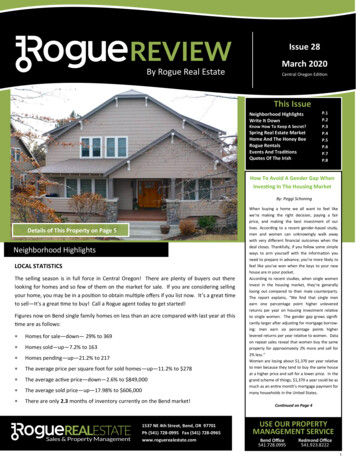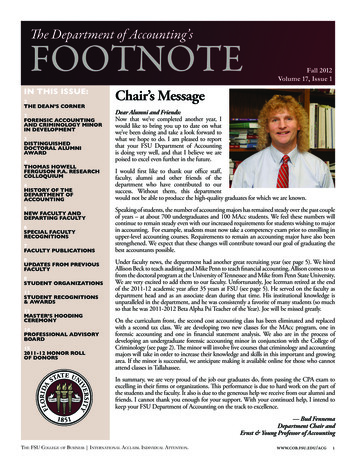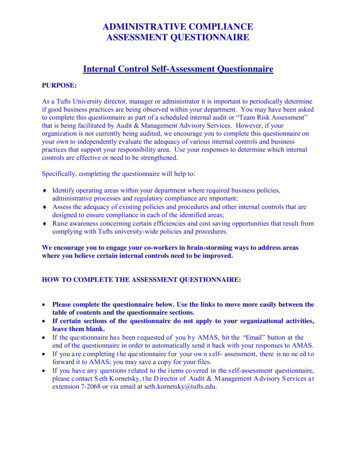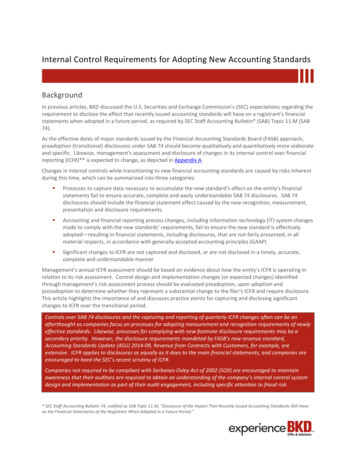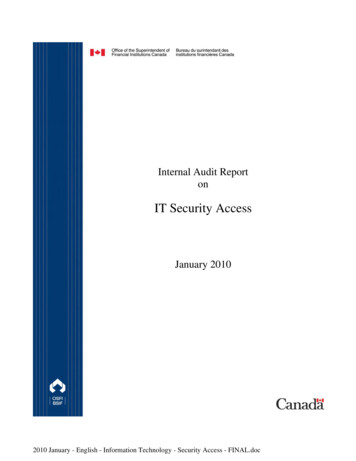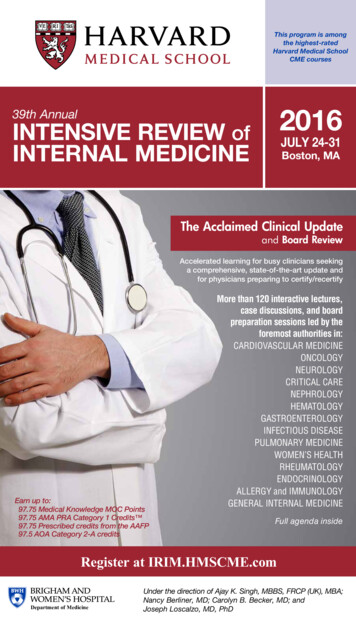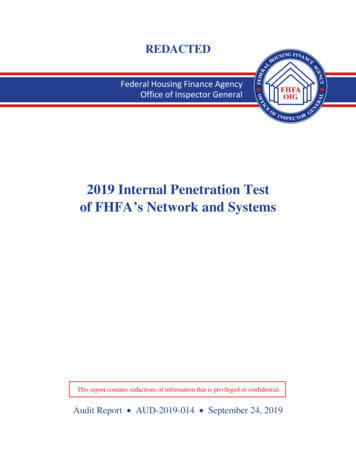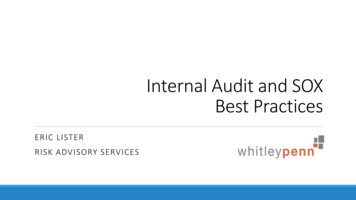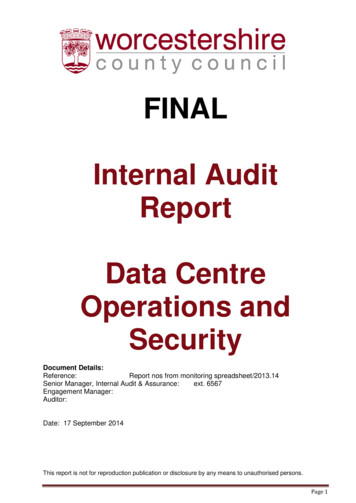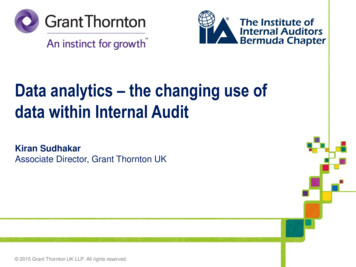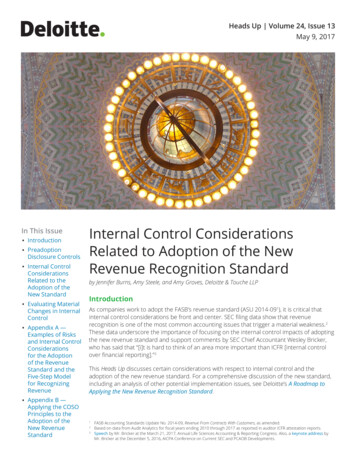
Transcription
Heads Up Volume 24, Issue 13May 9, 2017In This Issue Introduction Internal ControlConsiderationsRelated to theAdoption of theNew Standard PreadoptionDisclosure ControlsEvaluating MaterialChanges in InternalControlAppendix A —Examples of Risksand Internal ControlConsiderationsfor the Adoptionof the RevenueStandard and theFive-Step Modelfor RecognizingRevenueAppendix B —Applying the COSOPrinciples to theAdoption of theNew RevenueStandardInternal Control ConsiderationsRelated to Adoption of the NewRevenue Recognition Standardby Jennifer Burns, Amy Steele, and Amy Groves, Deloitte & Touche LLPIntroductionAs companies work to adopt the FASB’s revenue standard (ASU 2014-091), it is critical thatinternal control considerations be front and center. SEC filing data show that revenuerecognition is one of the most common accounting issues that trigger a material weakness.2These data underscore the importance of focusing on the internal control impacts of adoptingthe new revenue standard and support comments by SEC Chief Accountant Wesley Bricker,who has said that “[i]t is hard to think of an area more important than ICFR [internal controlover financial reporting].”3This Heads Up discusses certain considerations with respect to internal control and theadoption of the new revenue standard. For a comprehensive discussion of the new standard,including an analysis of other potential implementation issues, see Deloitte’s A Roadmap toApplying the New Revenue Recognition Standard.123FASB Accounting Standards Update No. 2014-09, Revenue From Contracts With Customers, as amended.Based on data from Audit Analytics for fiscal years ending 2010 through 2017 as reported in auditor ICFR attestation reports.Speech by Mr. Bricker at the March 21, 2017, Annual Life Sciences Accounting & Reporting Congress. Also, a keynote address byMr. Bricker at the December 5, 2016, AICPA Conference on Current SEC and PCAOB Developments.
Preadoption Disclosure ControlsThe SEC has been emphasizing the importance of transition-period disclosures (orpreadoption disclosures) in accordance with SAB 74.4 These disclosures should be bothqualitative and quantitative and should be included in MD&A (subject to disclosure controlsand procedures) and the footnotes to the financial statements (subject to ICFR). The SEC staffhas also made clear its expectation that the preadoption disclosures become more robustand quantitative as the new standard’s effective date approaches.In light of the SEC’s guidance and recent comments from the SEC staff, such disclosuresshould address the impact the new revenue standard is expected to have on the financialstatements and should include: A comparison of the company’s current accounting policies (which, to the extentavailable, could include tabular information or ranges comparing historical revenuepatterns) with the expected accounting under the new standard. The transition method (full retrospective or modified retrospective) elected.The status of the implementation process.The nature of any significant implementation matters that have not yet beenaddressed.A company that is able to reasonably estimate the quantitative impact of the new standardshould disclose those amounts. Some disclosures may therefore include pro forma financialstatements under the full retrospective method.Internal controls over these preadoption disclosures are important to management’s abilityto address the risks that the disclosures are inaccurate or incomplete. Management shouldfirst identify whether appropriate internal controls exist for the disclosures and then specifythe information and analysis used to support them. Then, management needs to test thedesign and operating effectiveness of the relevant controls given that they should be includedwithin the scope of management’s report on ICFR in the year before the adoption of the newrevenue standard, as applicable.When assessing whether appropriate internal controls exist with respect to the preadoptiondisclosures, management may consider whether procedures are in place regarding:45 Competence — The preadoption disclosures are prepared by competent individualswith knowledge of the new revenue standard and potential impacts on the company. Compliance — The disclosures meet the SEC’s requirements and guidelines.5 Review — The disclosures are reviewed by appropriate levels of management.Data quality — The quantitative disclosures (if known and estimated) are calculated onthe basis of reliable inputs that are subject to appropriate internal control.Monitoring — The company’s monitoring function (e.g., internal audit, disclosurecommittee, or audit committee) appropriately reviews the internal controls inaccordance with company protocols. In addition, the audit committee is involved inthe oversight of the disclosures’ preparation.SEC Staff Accounting Bulletin 74, codified as SAB Topic 11.M, “Disclosure of the Impact That Recently Issued Accounting StandardsWill Have on the Financial Statements of the Registrant When Adopted in a Future Period.” See Deloitte’s September 22, 2016,Financial Reporting Alert and Deloitte’s A Roadmap to Applying the New Revenue Recognition Standard for further discussion andrelated examples of SAB 74 disclosures.See the appendix in Deloitte’s September 22, 2016, Financial Reporting Alert and Deloitte’s A Roadmap for Applying the New RevenueRecognition Standard for a discussion and examples of SAB 74 disclosures.2
Internal Control Considerations Related to the Adoption of the NewStandardInternal Controls Over the AdoptionThere are often unique circumstances and considerations associated with the adoption of anew accounting standard that can pose a higher risk of material misstatement to the financialstatements. Thus, companies should consider the circumstances that may only be presentduring the adoption period and evaluate whether there are any unique risks that require “onetime” internal controls that may operate exclusively during the adoption period. Managementshould also consider the internal controls, documentation, and evidence it needs to support: Entity-level controls such as the control environment and general “tone at the top.” Accounting conclusions reached (such as by preparing accounting white papersor internal memos memorializing management’s considerations and conclusions),including the impact to other account balances such as costs of sales or services,contract assets and liabilities, and income tax accounts. Information used to support accounting conclusions, new estimates, adjustments tothe financial statements, and disclosure requirements. Identification and implementation of changes to information technology systems,including the logic of reports. The transition approach selected. Any practical expedients applied and related disclosures.Identification of material revenue streams and different contract types within thoserevenue streams.The accounting logic used and journal entries (including the transition adjustments)that record the adoption’s impact.Changes to the monthly, quarterly, or annual close process and related reportingrequirements (e.g., internal reporting, disclosure controls and procedures).See Appendix A of this Heads Up for considerations related to additional risks and internalcontrols.Five-Step Model, Related Risks, Internal Controls, and DocumentationThe new revenue standard requires companies to apply a five-step model for recognizingrevenue. As a result of the five steps, it is possible that new financial reporting risks willemerge, including new or modified fraud risks, and that new processes and internal controlswill be required. Companies will therefore need to consider these new risks and how tochange or modify internal controls to address the new risks.For example, in applying the five-step model, management will need to make significantjudgments and estimates (e.g., the determination of variable consideration and whetherto constrain variable consideration). It is critical for management to (1) evaluate the risksof material misstatement associated with these judgments and estimates, (2) design andimplement controls to address those risks, and (3) maintain documentation that supports theassumptions and judgments that underpin its estimates. Mr. Bricker recently pointed out thatmanagement should consider whether controls, including those related to tone at the topof the organization, “support the formation and enforcement of sound judgments [requiredunder the new standard] or whether changes are necessary.”6 Appendix A of this Heads Upoutlines the five-step revenue recognition model and contains sample risks and controls forconsideration.6Speech by Mr. Bricker at the March 21, 2017, Annual Life Sciences Accounting & Reporting Congress.3
Significant Changes in Information and Related Data-Quality NeedsCompanies will need to gather and track new information to comply with the five-step modeland related disclosure requirements. Management should consider whether appropriatecontrols are in place to support (1) the necessary information technology (IT) changes(including change management controls and, once the IT changes have been implemented,the testing of their design and operating effectiveness) and (2) the accuracy of the informationused by the entity to recognize revenue and provide the required disclosures. The table belowillustrates some potential challenges and examples of practices.Potential ChallengeExample of Internal Control Practice Management establishes data governance, policies, andstandards for identifying and resolving data gaps andimplements processes to verify the quality of informationneeded for implementation of the new standard. The revenue recognition implementation team meetsperiodically with the ICFR/SOX7 team (and control ownersas appropriate) to share relevant information about theadoption of the new standard so that the ICFR/SOX teamcan prepare and plan accordingly. Management takes steps to update and review theappropriate flowcharts, data flow diagrams, processnarratives, procedure manuals, and control proceduresto reflect the new processes as a result of the newstandard and to support management’s ICFR assessment.Information requirements havenot been updated to supportthe reporting (e.g., interim andannual requirements, includingdisclosures) required under thenew revenue standard. Control expectations havenot been considered for newinformation required under thestandard. Internal controls over source data,report logic, or parameters havenot been reconsidered.Applying the COSO PrinciplesThe Committee of Sponsoring Organizations of the Treadway Commission’s Internal Control —Integrated Framework (the “2013 COSO Framework”) provides a framework for designingand evaluating internal controls through the use of 17 principles and related guidance. Ascompanies implement the new revenue standard, particularly those that apply the 2013 COSOFramework in management’s assessment of ICFR, they should consider the COSO principlesin evaluating and designing controls (including those related to recognizing revenue and dataquality, as discussed above). In addition, as new controls are designed and implemented,control owners should consider the evidence and documentation that will be available tosupport management’s assessment of ICFR. See Appendix B of this Heads Up for furtherdiscussion.Evaluating Material Changes in Internal ControlSEC registrants are required to disclose any material changes8 (including improvements) intheir ICFR in each quarterly and annual report in accordance with Regulation S-K, Item 308(c).SEC guidance explains that materiality would be determined on the basis of the impact onICFR and the materiality standard articulated in TSC Industries Inc. v. Northway Inc.9 (i.e., that“an omitted fact is material if there is a substantial likelihood that a reasonable shareholderwould consider it important in deciding how to vote”).As discussed previously, the adoption of the new revenue standard will probably requiremanagement to implement new controls or modify existing ones to address new or modifiedrisks of material misstatement. Such changes in internal control, if material, as a result ofthe adoption of a new accounting standard, will trigger disclosure requirements. In addition,789Sarbanes-Oxley Act of 2002.SEC Final Rule No. 33-8238, Management’s Report on Internal Control Over Financial Reporting and Certification of Disclosure in ExchangeAct Periodic Reports, states that management “must evaluate, with the participation of the issuer’s principal executive and principalfinancial officers, or persons performing similar functions, any change in the issuer’s internal control over financial reporting, thatoccurred during each of the issuer’s fiscal quarters, or fiscal year in the case of a foreign private issuer, that has materially affected,or is reasonably likely to materially affect, the issuer’s internal control over financial reporting.”426 U.S. 438 (1976). See also Basic Inc. v. Levinson, 485 U.S. 224 (1988).4
management should consider whether there are appropriate controls with respect toidentifying and disclosing material changes in ICFR.For example, management may consider whether there are controls related to the following: Compliance — Processes are in place to identify and evaluate material changes ininternal control. Further, protocols exist for developing appropriate disclosures andreporting such information to appropriate levels of management (e.g., those signingthe quarterly and annual certifications required under SEC Regulation S-K, Item 601(b)(31)10). Review — The disclosures are reviewed by appropriate levels of management(including, as warranted, those signing the quarterly and annual certifications). Monitoring — The company’s monitoring function (e.g., internal audit, disclosurecommittee, or audit committee) appropriately considers the state of the entity’s ICFRto identify changes and monitors controls in accordance with company protocols.In addition, the audit committee is involved in the oversight of the disclosures’preparation.In developing the required disclosures, companies should clearly state whether a materialchange has occurred and, if so, describe the nature of the change. The SEC staff hascommented when a registrant has not explicitly asserted whether there has been a changein ICFR in the most recent fiscal quarter that could have a material effect on its ICFR. The staffhas further stressed that registrants should avoid “boilerplate” disclosure in which they statethat there have been no material changes affecting ICFR in a period, particularly when therehave been identifiable events such as changes in accounting policies.Illustrative Disclosures — Material Change in Internal ControlExample — Several Quarters Before AdoptionDuring the quarter ended June 30, 20XX, we implemented new controls as part of our effortsto adopt the new revenue recognition standard. Those efforts resulted in changes to ouraccounting processes and procedures. In particular, we implemented new controls related to: Monitoring the adoption process. Gathering the information and evaluating the analyses used in the development ofdisclosures required before the standard’s effective date.Implementing a new IT system to record revenue.Recording adjustments to the 2016 and 2017 financial statements for the fullretrospective transition method.We evaluated the design of these new controls before adoption during the quarter endedJune 30, 20XX. As we continue the implementation process, we expect that there will beadditional changes in ICFR. However, there were no other changes in ICFR during the quarterended June 30, 20XX, that materially affected ICFR or are reasonably likely to materially affect it.Example — Shortly Before AdoptionDuring the quarter ended December 31, 20XX, we implemented a plan that called formodifications and additions to ICFR related to the accounting for revenue as a result of thenew revenue recognition standard. The modified and new controls have been designed toaddress risks associated with recognizing revenue under the new standard. We have thereforeaugmented ICFR as follows: Enhanced the risk assessment process to take into account risks associated with thenew revenue standard. Added controls that address risks associated with the five-step model for recordingrevenue, including the revision of our contract review controls.There were no other changes in ICFR during the quarter ended December 31, 20XX, thatmaterially affected ICFR or are reasonably likely to materially affect it.10SEC Regulation S-K, Item 601(b)(31), “Exhibits.”5
Illustrative Disclosures — Material Change in Internal Control (continued)Example — Upon AdoptionWe implemented the new revenue recognition standard as of January 1, 20XX. As a result, wemade the following significant modifications to ICFR, including changes to accounting policiesand procedures, operational processes, and documentation practices: Updated our policies and procedures related to recognizing revenue and addeddocumentation processes related to meeting the new criteria for recognizing revenue. Modified our contract review controls to take into account the new criteria forrecognizing revenue, specifically the identification of implied promises and theevaluation of whether performance obligations are distinct in the context of thecontract. Added controls for reviewing constrained variable consideration and reevaluating oursignificant contract judgments and estimates on a quarterly basis. Added controls to address related required disclosures regarding revenue, includingthe disclosure of performance obligations and our significant judgments and estimatesfor determining the transaction price and when to recognize revenue.Other than the items described above, there were no changes in ICFR during the quarterended March 31, 20XX, that materially affected ICFR or are reasonably likely to materially affect it.6
Appendix A — Examples of Risks and Internal Control Considerations for the Adoption ofthe Revenue Standard and the Five-Step Model for Recognizing RevenueCore ConsiderationsExamples of RisksExamples of Control Considerations11Adoption period Internal controls related to:1.Identify thecontract withthe customer Accounting conclusions arenot accurate or complete. The recording of theadoption of the revenuestandard is not accurate orcomplete. IT logic for reports andjournal entries is notaccurate. Revenue is/is not recognizedwhen a contract (as definedby the new revenuestandard) does not exist/does exist.Five-Step Model 2.3.11Identify iceAll material revenue streamsand contract types are notidentified. Side agreements exist thatare not known to accountingpersonnel.Performance obligations arenot properly identified.Management’s estimatesare inaccurate as a result ofan inappropriate methodor inappropriate significantassumptions. Identifying and evaluating all material contract types. Documenting and reviewing accounting conclusions and revisedaccounting policies. Reviewing the application of the transition method elected.Identifying the complete population of contracts to evaluate.Evaluating whether the data used to record adjustments to thefinancial statements is accurate and complete.Identifying, developing, and implementing new systemrequirements, including logic of reports.Internal controls related to: Identifying contracts that meet the criteria defined in the newstandard. Reassessing arrangements that do not initially meet the criteriaof a contract in accordance with the new standard given thatsignificant changes may occur in the underlying facts andcircumstances. Assessing management’s commitment and ability to performunder the contract. Ensuring payment terms are properly considered. Evaluating contract modifications.Assessing the collectibility criterion.Evalua
4 SEC Staff Accounting Bulletin 74, codified as SAB Topic 11.M, “Disclosure of the Impact That Recently Issued Accounting Standards Will Have on the Financial Statements of the Registrant When Adopte
